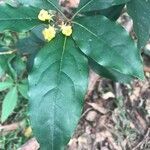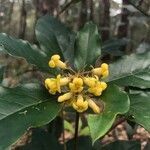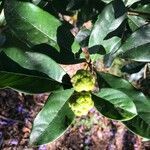Shrub or small tree 1–4 m high, very polymorphic. New shoots, leaves and inflorescences with a dense indumentum of either uniseriate glandular hairs or long base T-hairs with the cross cell golden brown or clear, flat, long, ribbony. Seedling leaves immediately alternate, sparsely hairy upper, densely hairy lower, winged to base including petioles to 8 mm long; midrib corrugated/ridged. Adult leaves becoming whorled at branch ends, narrow elliptic, 80–145 mm long, 35–55 mm wide (longer, thinner and wider forms in dense shade and optimal coastal rainforest habitats), mucronate; abaxial surface usually densely hairy with golden-brown, long-base hairs. Inflorescences with floral axes distinct from vegetative; terminal umbels, male plants more floriferous; bract scales persisting at the base, bracteoles leaf-like on 6 mm peduncles, pedicels thick/ stout, densely hairy. Sepals 6–8 mm long, very slightly cohering at thick bases, unequally lobed, margins and midribs with paired hairs, apices acute, spiky. Petals 13–15 mm long, cohering in throat, then recurving, margins hairy; cream to yellow. Both male and female flowers have ovaries densely golden hairy with long-base T-hairs, with a basal, lobed nectary. Male flowers: anthers exserted, to 3 mm long, oblong, sinus 1/3 from base, apex with mucro; filaments slightly adnate to petal joins in bud, 7–8 mm long, tapering. Pistil appearing cryptically perfect except that the style is longer than the ovary, and almost as wide, stigma barely differentiated, ovules few. Female flowers: have vestigial anthers less than 1 mm long, without pollen and not exserted past the corolla throat; filaments very wide, flared and short. Pistil with fat lobed stigma, a short stout style (3 mm) and a cylindrical 6 mm long ovary; placentas run the full length of the ovary with numerous ovules inserted in up to four rows per loculus; incompletely bi or trilocular. Fruits are loculicidally dehiscent capsules, 20–25 mm long, thick bi-and sometimes trivalved , tetragonal, and woody, bullate, orange-yellow, endocarp bright yellow; seeds 50–78, red, glossy, globular, margins frilled, sticky and cohering.What does this mean for infloresences?Are they really male flowers if they produce ovules?
More
A tall erect shrub. It can be 2-6 m tall. It can spread 2-5 m across. It has creeping underground stems. The young leaves are pink and silky. The mature leaves are deep green, glossy and narrowly oval. They are 5-15 cm long by 1.5-6 cm wide. The edges are slightly wavy. The veins are easy to see. The leaves can have rusty hairs underneath. The flowers are yellow and like tubes and have a sweet smell. They are 1.5 cm across. The lobes spread and roll back. Flowers are in small clusters at the ends of branches. The fruit is an orange capsule 2.5 cm across. It splits open to reveal bright red seeds.



